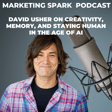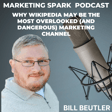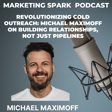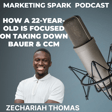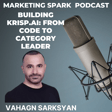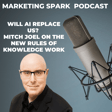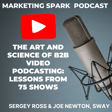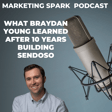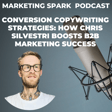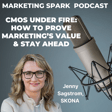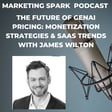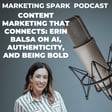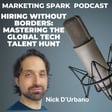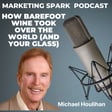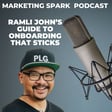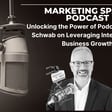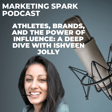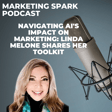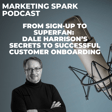Become a Creator today!Start creating today - Share your story with the world!
Start for free
00:00:00
00:00:01

Know Your Customers, Win More Deals: A Deep Dive with Yael Morris
In this episode of Marketing Spark, I sit down with Yael Morris to discuss why truly understanding your customers is the key to effective marketing and sales. We explore how deep customer insights drive better messaging, positioning, and product decisions—and why so many companies get it wrong. Yael shares real-world examples of brands that excel at customer intelligence and offers practical strategies to gather and apply these insights. If you’re looking to sharpen your customer understanding and boost engagement, this conversation is a must-listen!
Transcript
Understanding Customer Motivations in B2B SaaS
00:00:12
Speaker
Hey, it's Mark Evans, and you're listening to Marketing Spark. In this episode, we're going to tackle a huge challenge for many B2B stats companies, really knowing who matters to them and why customers buy. and Too often, companies rely on educated guesses or anecdotal feedback. They might think they understand their audience, but in reality, they're missing a huge opportunity to uncover deeper motivations and triggers that drive purchase decisions.
Introducing Yael Morris and Decode Insights
00:00:38
Speaker
That's why I'm excited to have the I.L. Morris from Decode Insights on the show. The I.L. specializes in helping businesses understand customer behavior, turning assumptions into insights, and vague market perceptions into crystal clear customer intelligence. We'll be exploring how knowing your customers can transform everything from product development to messaging and ultimately lead to sustainable growth.
00:01:02
Speaker
If you're ready to move beyond guesswork and unlock the real reasons people choose your product, stay tuned. This conversation will resonate. Welcome to the podcast. Thanks for having me, Mark. It's great to be here with you.
Misunderstanding Customer Language
00:01:15
Speaker
Super excited about our conversation. I talk and write a lot about the fact that most businesses unfortunately don't know their customers well enough. Don't talk to their customers. Don't engage with them. Don't understand how they feel and think and do. You spend a lot of time and helping companies get better insight into the people that matter to them. I want to talk about your take on helping businesses discover why customers actually buy. As important, I want to get your definition on why customers buy and why it's critical for companies to uncover this core motivation. This strikes me as marketing 101 or sales 101, but a lot of companies aren't doing it. It would be great to get your perspective on this whole information gap that we're struggling with.
00:02:12
Speaker
That's a really good question. It's something that I spend a lot of time trying to educate my clients on and and my audience as well on LinkedIn. People don't buy features. They're not actually buying the product.
00:02:25
Speaker
They experience a pain, a problem, a struggle, a frustration, and it it brings about an urge to solve it. They want an outcome. They don't want a benefit. They don't want a feature. They want an outcome. They want to get their problems resolved and close the gap between their current state and desired state.
00:02:48
Speaker
The real definition of why customers buy is because they watch their problem solved. They have a problem. Oftentimes, businesses are speaking in terms of their product and feature and not really in terms of the customer's language and their real lived experience. In the B2B SaaS world, a place where both you and I play, product is king. There's so much time, effort, and money spent building and adding more features.
00:03:19
Speaker
Does that explain why companies spend so much time talking about benefits and features and not enough time for the problems of customers? Businesses like to talk of their own talk because it's easier to. We've built this feature that we love because it'll help you do this. But it's not really speaking in terms of the customer's language. You have to get down to earth to understanding the little nuances out of how somebody is experiencing their own situation. What does their real lived experience look like?
00:03:57
Speaker
when they're running into their own walls and how does your problem then alleviate that struggle? So businesses love to, especially SaaS companies because it is all about product and features and the tech. They love to talk about that tech because that's what
Why Avoid Direct Customer Engagement?
00:04:10
Speaker
they're they think they they're selling, but they're not selling that. They're selling in outcome. They're selling a resolution to a problem that the customer is experiencing. The question that we're dancing around is,
00:04:23
Speaker
why companies, marketers, or salespeople don't talk to customers directly. Why don't they do that more proactively or aggressively? The more you know about your customers, the better decisions you're going to make because you understand how they think and feel and how they behave. What's that barrier? What's that obstacle or that thing that stops many companies from engaging their customers or in prospects?
00:04:53
Speaker
I feel like I'm the wrong person to answer this question, but I love that question. The reason for why I'm not a good person to answer it is because when I was in a sales role, I was the person asking the customers, I so actually stopped selling and I went on to discovery mode and research. that how That's how I started off this career. The question is obvious. Why do our customers buy that? I think people totally overlook it. And it's easy to just sit in our own assumptions and believe what we think we know.
00:05:18
Speaker
Obviously, I know where customers buy. I speak to many founders and CEOs, and I do ask the question, do you know why your customers buy? Of course we know why they buy. They think they really know the reason. It's because they've almost communicated this narrative to themselves about why their customers buy, and they've crafted this narrative that they then really believe.
00:05:39
Speaker
The second thing is the question is really uncomfortable. It's uncomfortable to go to your customer and really try to uncover what were the real reasons for why you bought. The real reasons often lie, like I mentioned previously, they often lie in this pain, in this struggle. Talking about those struggles and digging deep into them to get the customer to reveal and describe and go back in time to experience those struggles is not a comfortable conversation. It's very uncomfortable for the person who's on the interviewing side. To go to your customers and ask for a conversation about their pre-lived experience of struggling and ask them to just give them your time so you can ask about these things is not something that's easy yeah and and effortless. You have to be vulnerable to go and do it.
00:06:28
Speaker
The third thing is salespeople's job. Their job is to uncover those pains in those discovery conversations. When a customer comes to them, it's their job to crystallize and define the problem for the customer that they're experiencing. And no shot at salespeople. but The most don't actually do that. Really good ones do. But they don't actually do that. When marketing and sales are talking amongst there' each other, salespeople can't really tell the marketing team why really customers are buying. They only scratch the surface and get a surface-level definition. Many marketing people tell me they listen to Gong recording. They listen to their sales calls to understand why customers buy. PMMs also tell me something.
00:07:15
Speaker
I ask them, what do you hear and learn from those conversations? They tell me up here about why customers are looking for the product and what they're experiencing. And I ask how, you know, specific do you get? Do you really get deep? What kind of questions are being asked? And when I get into that kind of conversation with the marketer, they end up revealing, and we don't really know why the customers are about. I think it's those three reasons.
00:07:40
Speaker
I wish the mystery of companies not talking to customers who could be solved. Your company, Decode Insights, emphasizes understanding customers better than they know themselves. It'd be awesome if companies could actually do that. Can you walk me through the approach or methodology that helps you get inside customers' heads
Aligning Strategies with Customer Journeys
00:07:58
Speaker
so effectively? What do you do that allows you to get these insights? And is your approach different than what other consultants or other companies would do?
00:08:09
Speaker
What I do is work with a a client and what's the problem that's that the business is experiencing. case sales Usually it's a sales problem. We are unable to get the conversion rate that we want. Retention is not where we want it. Sales are not where we want it. We target their customer base. We ask either it's an introduction or a call or an email.
00:08:29
Speaker
we set up about an hour with each customer. It's around 10 to 20 customers depending on the size of the customer base and how much we're trying to understand, but it takes between 10 to 20 conversations to really get crystal clear. There's a diminishing rate of return when it comes to the insight that you gather. In those conversations,
00:08:47
Speaker
We build a relationship with the customer and we make it very obvious that we're not here to sell you anything. We're here to understand you. I think that's the advantage that you have as a third party person. I have no stake in this business.
00:09:01
Speaker
We walk through the customer's buying journey prior to the buying journey of what were you doing before? What did that look like? Tell me about the specific experience. I actually say I have no idea what you're talking about. like I need to know specifics because I'm completely blind to whatever you did before.
00:09:21
Speaker
It can be anything. And so they walk me through their process of what they did. And I ask questions like, how did that make you feel? Why did that bother you? What was the frustration? I get very specific on the pains through digging and probing and getting clear and clear about the real lived down to earth.
00:09:41
Speaker
human problem and suffering that they experienced, you then uncovered the exact pains that they had, then what motivated them. Then we get into the desired outcome, what the business had actually solved for them. What is the real difference between before and now? What does it now let you achieve? And why is that so important to you? What impact has that had in your life and in your business and your bottom line?
00:10:05
Speaker
We get so clear on the importance and the desire for that outcome that the pieces really connect there that way. Then I go back to my client and I say, this is the exact problem and this is why the problem occurred in the first place. This is the context around it. Context is so key here. If you don't understand the full story,
00:10:27
Speaker
Then you're just looking at your customer's experience as a, you objectify it in a certain way. You put it in this box where it's not in this box. It's like you have to look at the whole human experience. When I get the contacts from my clients, things get a lot more clearer for them.
00:10:43
Speaker
The other word that's jumped out was perspective dove and what people like you and I and and third parties bring to business decisions. One of the challenges face that entrepreneurs face is that they're living in the eye of the hurricane or or inside the bubble. Sometimes they embrace biases or points of view that are hard-coded, they're embedded in the way that they think and what they do, it makes them blind or it doesn't allow them to see what they should see. When I do brand positioning engagements, for example, I will ask clients if I can talk to their customers. Sometimes they're reluctant, which is always surprising, but what customers tell me because I am a third party, because I'm not vested,
00:11:28
Speaker
Is always surprising when i go back to the client and i say the customer said this. It's really interesting to hear when they're surprised when they are told something that they didn't know or they weren't aware of.
00:11:44
Speaker
That's the value of using a third party because they come into it with a clean slate. They haven't drank the Kool-Aid yet. That is a real advantage and I think that's one of the reasons why in addition to your methodology that you can get the insight that you do. The other question I wanted to ask you is fundamentally about but customer research and knowing your customers is often there's a gap between what customers say and what they actually do. How do you bridge that gap to get the truth ah about customer intentions and behaviors?
00:12:12
Speaker
It's less about what they say and what they do. It's what they mean by what they say. My role in any business is to understand the root triggers, the drivers behind people's behaviors and motivations. What do they really want? They're not buying something because of what they say.
00:12:35
Speaker
What they say is what they say. It's the first thing that comes to mind. It's how they express themselves. When you understand and you go deeper into, okay, why? What does that actually mean? What are you trying to achieve here? That's the real root cause behind the decision. People behave in all these ways, but there's always a reason for why they do it. If you don't understand the reason, then you can't make sense of what they do.
00:12:58
Speaker
That is interesting because it sometimes it's a real challenge to get people to open their kimono, to use an analogy. They'll give you answers, but they won't tell you the truth. That's what I'm digging at. I'm just trying to figure out how you get to tell them how they really feel or what they really do.
00:13:20
Speaker
Is that a matter of building a relationship? Is asking the right questions or trying to go as deep as possible rather than looking for surface level insights? Is that part of your methodology?
00:13:33
Speaker
i I wouldn't say it's a methodology. It's a mindset. People will say something, but they mean something different. but You have to understand, what did you mean by that? To them, it's obvious. I want this because it's cool. right I give this an analogy of of people buying a shoe. Someone's looking for a comfortable shoe. You ask them, why did you buy this shoe? It's a comfortable. That's not why they bought the shoe.
00:13:55
Speaker
They bought the shoe because they are on their feet all day. And in order to perform their job properly, they need to be focused. Imagine a surgeon. They need to be standing for long periods of time. And if without these comfortable shoes, they will be uncomfortable, unfocused, distracted, not at their best. They won't feel like they can't pay attention to what they're doing. They're buying these shoes so they can go about their day effortlessly. And that's why comfort is important.
00:14:21
Speaker
But it's not just because the shoe is comfortable. That's not right about the shoe. This is what I mean by understanding context. You have to understand the context of the real lived human experience and the pain and struggle that they experience. Then what do they really want out of it? What's the desired outcome? They want to be able to perform these procedures effortlessly.
00:14:38
Speaker
They want a successful procedure. They don't want to be distracted. They don't want to have anything that gets in their way. Requires a lot of probing. You can't just accept what people just say on the surface. it There's always a reason behind what they mention to you in that interview, in that conversation. A lot of the time, it does require building a rapport, building momentum and energy at the beginning. we People feed off of each other. Before I start any kind of entry interview, there's about five minutes where we're just chatting.
00:15:07
Speaker
You do the interviews, dig deep into why customers do what they do and why they make purchases. You get the context so that you can provide clients with value added information.
00:15:23
Speaker
But the reality is is that there's a bridge if you to fill. What you learn could or should ideally inform every touch point within a company, from branding to product design to customer service to marketing and sales. All this information is important and all this information matters and can make a difference to every part of the organization. How do you help companies weave these insights into every corner of the business. How do you make sure that what you do is an orchid piece of research that collects dust and people hit the check mark. We talk to our customers, we get customer insight. How do you help them make sure this insight is embraced and it makes a difference in the business?
00:16:09
Speaker
Because
Influence of Insights on Business Aspects
00:16:10
Speaker
these insights matter to every single person because at the end of the day, it's the customer, but matters to every department in an organization. Someone just told me yesterday, we've been relying on your insights for all our messaging. All our messaging is completely different now. I have various case studies on how product design and their approach to their product strategy has completely changed, their positioning strategy, et cetera. I think though, the real Connect comes in when these insights are presented to them and I speak to the insights. I speak to the customer story. I speak about what these customers really feel. I bring that emotion into it because through that presentation is when my clients and their teams can really start to understand and absorb what it means. I'm able to provide them with the context.
00:17:04
Speaker
What I deliver is not this long-winded report that you need to read through and and just consistently reference. It's a concise document that you really crystallizes what matters to your customer and why, and then what does this mean to you.
00:17:22
Speaker
I think that going back to what matters to our customer and why, you're constantly able to change the way you approach your business decisions and your business strategy because it's rooted in, okay, how do we make sure that this is just constantly, directly aligned with what matters to our audience and our customer base?
00:17:41
Speaker
You mentioned a client that embraced your insights and how it made them change their messaging. Can you give me an example of a client that that where you feel your insights were embraced and resonated to the point where the company took a different approach, whether it was marketing or sales or product development?
00:18:03
Speaker
I've been working with a business that was a manufacturing clothing company. They were celebrating 100 years and were trying to change the way that they wanted to be positioned in the market.
00:18:21
Speaker
It was a 100-year-old company, and I went to the C&Ls. There's something that's not connecting for me here because you're a 100-year-old brand, and your customer's been buying from you for a reason. I ended up interviewing 20 of their customers. After those conversations, I got very specific about exactly why they buy this product. It was
Case Study on Strategy Realignment
00:18:42
Speaker
because no other product was able to have this specific design, this shape, this customization, and this service delivery, and this color, and this pattern,
00:18:51
Speaker
The company was trying to go in a completely different direction and they had started to, and they started to lose customers as a result. Their sales went down. It went back to them and I said, do you know why your customers really buy from you? It's because they don't have a vendor that does ABCD for them. Because when their customers into B2B, B2B to C company,
00:19:13
Speaker
When their customers, they're trying to sell it to their clients, they're needing this kind of product. You're the only one in the market that does this. They always think of you when the customers come to them and they need this specific thing. Now you've changed your product. We're super unhappy because they're trying to be something that they're not. Customers have said that to me. This company is trying to be something that they're not. It went back to my client and I said, these are the reasons why your clients are buying and now this is why they're not buying.
00:19:40
Speaker
About a year later, I called up my client, the CEO, hey, like, what are you end up doing with these insights? How's the business going? And he goes, we've actually changed everything. We went back to our core strategy. We sharpened our pricing, we sharpened our product design, we saved $2 million dollars on inventory, customer retention, it's the highest it's ever been, 98%. Sales have gone up.
00:20:00
Speaker
I think that's a testament to if you really understand the underlying motivations behind why your customers are buying from you, you're able to make informed product pricing, positioning, business strategy decisions. I understand giving the customers what they want, but one of the realities, especially in B2B SaaS, is that technology evolves.
00:20:23
Speaker
innovations emerge, new ways of doing things are created and embraced. So the, that technology landscape is very volatile and ever changing. And at the same time, consumer tastes.
00:20:41
Speaker
evolve and change. What's important to consumers at one point in time is less important in the future. For example, when times are really good, a lot of companies are looking for ways to drive growth. When times are tough, a lot of companies want tools and software to save costs. Same product, but they're looking for different things. What I'm interested in your take is How do you help clients keep up with rapidly shifting customer preferences so that your insights are relevant to them, impactful, and valuable? Because you know what you asked the customer six months ago, may and what's important to them may be different than what's important to them today. So how do you keep that to make sure that customers are you know always in tune with what's going on out there?
00:21:36
Speaker
There's this notion that people's preferences change super rapidly because we're so focused on features. We're so focused on features and benefits and keeping up and differentiating ourselves outputs. When I think what is being missed is what are people's current real experiences? How frequently do your preferences really shift? How quickly do they really evolve when it comes to a need for a specific type of product?
00:22:02
Speaker
There's definitely something to be said to that, however. And the answer lies in constantly being in touch with your customers and asking those questions and understanding their expectations, their needs and unmet needs. What comes down to the core things, people want time to be saved. People want to make more money. People want to buy more time. People want less headache. People want to do things more easily. They want to feel better, be more comfortable. It comes in that these basic foundational needs.
00:22:31
Speaker
The answer lies in you constantly being in touch with your customers because their needs and desires and and goals do evolve and you need to make sure that you're constantly in tune with them.
00:22:44
Speaker
One final
Challenging Assumptions for Insight-driven Strategy
00:22:45
Speaker
question around your advice to entrepreneurs, CEOs, business leaders who want to take the first step in deeply understanding their customers. What would be the one piece of advice you would give them to start a more powerful, insight-driven strategy?
00:23:04
Speaker
Challenge everything that you think. If you think this about your customer and you think that this is a problem, challenge that by speaking with them and asking them the really uncomfortable questions about why. And just constantly ask why until you're crystal clear.
00:23:25
Speaker
Great advice. It's been a great conversation. Really enjoyed it. Always like to learn about how we can understand our customers better. Where can people learn more about you and what you do?
00:23:38
Speaker
Thanks so much. Go to my LinkedIn, Yael Morris. i I post on there daily or even twice a day. I talk about real customer conversations, case studies, my own experiences, questions I ask. I make sense of what people think and why they buy. Maybe that can help other entrepreneurs and marketing leaders.
00:24:01
Speaker
Awesome. Thanks, Yellen. And thanks for everyone for listening to another episode of Marketing Spark. If you enjoyed the conversation, rate it, subscribe via Apple podcasts, Spotify, or your favorite podcast app, and share it via social media. If you're a B2B or SaaS company with one to $10 million dollars in sales, and you're looking for traction and scale, we should talk about how I can help you as a fractional CMO and strategic advisor. You can reach out to me via email, mark at markevans.ca, connect with me on LinkedIn or visit marketingspark.co. I'll talk to you soon.
